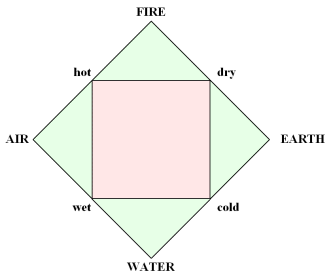Classical element
|
|
Several ancient Classical Element ideas exist. The Greek version of these ideas persisted throughout the Middle Ages and into the Renaissance, deeply influencing European thought and culture.
| Contents |
Classical elements in Greece
The Greek classical elements are Fire, Earth, Air, and Water. They represent in Greek philosophy, science, and medicine the realms of the cosmos wherein all things exist and whereof all things consist.
Plato mentions them as of Pre-Socratic origin, a list created by the ancient philosopher Empedocles.
- Fire is both hot and dry.
- Earth is both cold and dry.
- Air is both hot and wet.
- Water is both cold and wet.
One classic diagram (right) has two squares on top of each other, with the corners of one being the classical elements, and the corners of the other being the properties.
According to Galen, these elements were used by Hippocrates in describing the human body with an association with the four humours: yellow bile (Fire), black bile (Earth), blood (Air), and phlegm (Water).
Some cosmologies include a fifth element, the "quintessence." These five elements are sometimes associated with the five platonic solids.
The Pythagoreans added idea as the fifth element, and also used the initial letters of these five elements to name the outer angles of their pentagram.
Some occultists have noted that in modern science the general rule is that most visible matter can be classified as either a solid (Earth), liquid (Water), or gas (Air); a fourth classification has been discovered recently and is often called plasma (Fire). These correspond to the modern-day States of Matter.
Aristotle added aether as the quintessence, rationalizing that whereas Fire, Earth, Air, and Water were earthly and corruptible, the stars were eternal ("aether" is based on Greek for eternity) and were thus not made out of any of the four elements but rather a heavenly substance. The word aether was revived by early 20th century physicists as a term for the proposed invisible medium which permeated the universe, the luminiferous aether. The non-existence of this aether led to the overthrow of Newtonian physics and paved the way for Einstein's theories of relativity.
Classical elements in Hinduism
The classical elements in Hinduism are: Bhoomi (Earth), Jala (Water), Agni (Fire), Vayu (Air) and Akasa (Space). Together they were known as Panchabhootha (five elements).
Classical elements during the Middle Ages
The idea of the classical elements was known during medieval times, and, like much Aristotelian dogma, composed a large part of the medieval world view. The Catholic Church supported the Aristotelian concept of aether because it supported the Christian view of earthly life as impermanent and heaven as eternal. References to the classical elements in medieval literature are numerous and can be seen in the work of many writers, including Shakespeare:
- Thou hast as chiding a nativity
- As fire, air, water, earth, and heaven can make,
- To herald thee from the womb
- -PERICLES, from Pericles Prince of Tyre
- The cock, that is the trumpet to the morn,
- Doth with his lofty and shrill-sounding throat
- Awake the god of day; and, at his warning,
- Whether in sea or fire, in earth or air,
- The extravagant and erring spirit hies
- To his confine
- -HORATIO, from Hamlet, Prince of Denmark
Astrology and the classical elements
For the main article on this subject, see astrology and the classical elements.
Astrology has used the concept of classical elements from antiquity up until the present. Most modern astrologers use the four classical elements extensively, and indeed it is still viewed as a critical part of interpreting the astrological chart.
Chinese classical elements
Main article: Five Elements
In Chinese (Taoism) there is a similar system, which includes Metal and Wood but excludes Air. Different things in nature are associated with the five types. For example, the five major planets were named after the elements: Venus is Metal, Jupiter is Wood, Mercury is Water, Mars is Fire and Saturn is Earth. Also the Moon represents Yin, the Sun represents Yang. Yin and Yang and the five elements are recurring themes in the I Ching, which is strongly related to Chinese cosmology and Chinese astrology.
Some South Asian traditions also include the Air, Earth, Fire, Water distinctions.
Influence of the classical elements
The modern scientific periodic table of the elements and the understanding of combustion (fire) can be considered successors to such early models.
Interestingly, if one associates the modern term 'plasma' with Fire -- a fairly accurate mapping, as flames are in fact a visible plasma -- the four elements correspond to the modern 'states of matter' -- solid mapping to Earth, liquid to Water, and gas to Air. However, as the ancient Greeks had no experience with other states of matter -- such as Bose-Einstein condensates -- it is understandable that these are not represented in the classical system.
Other Thought of Classical Elements
Much of modern fantasy literature uses the elements. Typically, a magic wielder has the ability to influence one of the elements, or can use the elements to affect the world around him.
See also
| Classical Elements
Western Chinese |
eo:Klasikaj elementoj fr:Quatre éléments nl:Element (oudheid) pl:Żywioły pt:Quatro elementos ru:Стихия (алхимия) simple:Classical element

